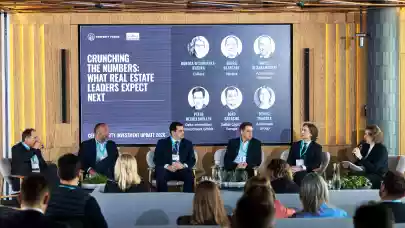
The pandemic brings a substantial evolution rather than a catalyst for a revolution. It accelerates ongoing changes in real estate strategies that otherwise would have taken years to implement, says Arkadiusz Rudzki, Executive Vice President of Leasing & Sales at Skanska office development in CEE, who shared his thoughts on workplace trends with Property Forum.
In the first months of the COVID-19 pandemic, flexible office space operators had a really hard time, dealing with quick termination of contracts and temporary suspension of decision-making. A year later it seems they can be the biggest winners of the new reality. What has changed?
True. It was a challenging period for the sector of flexible office space. For the first few months of the pandemic, the flexible office space operators faced a major challenge. But the strongest players knew that in a long run the changes caused by the pandemic would be an opportunity for them to grow. Coronavirus sparked a discussion about flexibility in office lease and accelerated a trend that had been observed for years: combining core space and flexible space. Business Link, the provider of serviced offices in Skanska’s CEE office unit, has noticed that more and more companies are interested in including serviced offices permanently in their office lease strategies.
So we may say that flex offices are no longer just a "cool" marketing attribute, attracting mostly start-ups and freelancers?
As I said, the pandemic brings a substantial evolution rather than a catalyst for a revolution. It accelerates ongoing changes in real estate strategies that otherwise would have taken years to implement. The Business Link product is mainly for corporate clients who need flexibility in building their office space strategies. The pandemic made large players, who are also strong in terms of their finances, stay at flex offices. Our report is also meant to start a dialogue with investors who are beginning to find out that the availability of flex space in their office buildings can have a positive impact on their business.

Arkadiusz Rudzki
Executive Vice President of Leasing & Sales
Skanska office development in CEE
In your recent report, “Workplace Flexibility Vademecum” you mention the so-called 70/30 rule. Could you please elaborate on that?
Some years ago, we had a definition of rule 70/30 as follows: 70% of the workplace was allocated to open space, and 30% was adopted for individual purposes. After that, 70% was working space and 30% was for cellular offices, conference rooms and common areas for social interactions. Basically, we ended up with personalized solutions for each and every occupier, but this rule was (and on some markets it still is) a kind of benchmark for discussion with our tenants. Referring to the trend described in our report – nowadays, organizations will search for a combination of long and short-term workplace engagements. The majority of workplaces will be still core but 30% will serve as a third space: physical workspace between the office and home. I think this trend will get more important because it reflects the times of uncertainty. This combination gives a unique opportunity to manage the deployment of staff according to both to the business needs and the epidemiological situation.
It is worth noting that 70/30 is our average prediction. Each tenant is different and each one has its own internal office space management strategy. Companies will ultimately decide for themselves what part of their offices will be the serviced space.
Numerous satellite offices, dispersed in the city outskirts – what group of companies would benefit from that model most?
The employees still appreciate the favourable conditions provided by physical offices – ergonomics, the opportunity to collaborate, get connected, and get inspired. According to Skanska's study, although 64% of office staff in CEE have good working conditions, almost 50% out of them go to their office every day. A satellite office strategy works when a single, central head office and employees’ own homes are not enough. The network interconnects head offices, homes, and smaller offices within an urban area.
The pandemic has shown people how much time they can save when they do not have to commute. It has also made clear that people struggle with working from home because it is not always as comfortable as it might seem at first. In this situation, satellite offices, located near dormitory suburbs, are a good solution. They eliminate the discomfort caused by commuting and get a status of something like a third space for the employees who live outside city centres. It is a model somewhere between home and office. Please note, however, that satellite offices will be on top of that - as a form of employee benefit. It is the head office, or core space, where companies will continue to build and strengthen their organizational culture. The time of commuting from suburban locations will define the attractiveness of the satellite model. Once it is around half an hour, we assume that people will prefer to come to the core office.
On the one hand, in the nearest future, tenants will push for shorter leases for smaller offices. On the other hand, investors will still require well-secured, long-term leases. How is Skanska going to deal with this conflict?
We have two legs in our business. Because of the coronavirus situation, corporate clients want business stability, and some of them (especially from the sectors that have been more seriously affected by the pandemic) are less eager to engage in long-term leasing agreements. On the other hand, we also have investors who need to be sure that the buildings they want to buy are a good investment of their capital – they want to be positive that their money is safe, and that the buildings are well-secured. The flexibility is a perfect solution for both sides. Why? The flex model will become an optimal solution to supplement an extended lease agreement – the investors can be sure that it is still beneficial to them.
The investors know that flexibility does not mean that agreements get worse. For this to happen, however, several key conditions must be met. Things such as what part of the space is occupied by a serviced office, whether they deal with a satellite office model, what the location is and, above all, who the tenant is – these elements are important for all investors. If the tenants are companies from the pharmaceutical, IT, technology or financial sectors, the investors will choose such an office building despite shorter lease agreements the tenants have rather than an office building with long lease agreements, but with pandemic-affected tenants. An optimistic observation is that in the sectors that have not been affected by the pandemic we cannot see pressure for shortening the leases, but of course, flexibility for future growth or adjustment of the size of the premises during a lease is very high on the agenda. It is right here that the flex or serviced offices are very supportive.
Aren’t you afraid that flex offices may be just a temporary solution for work in difficult situations and companies will return to their offices when the pandemic is over?
The flexible workplace strategies are practical ways of executing the planned office strategies of serious corporate players – hence, buildings or complexes with flex spaces are becoming an essential asset in investors' portfolios. Consequently, I think that this is definitely not a temporary trend, but the reality that we should accept as soon as possible.



